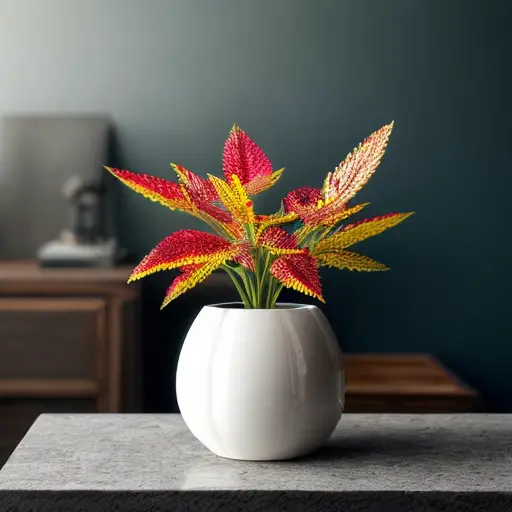Introduction to Ruda Plant: Understanding its Origins and Characteristics
Welcome, fellow plant enthusiasts, to the intriguing world of the Ruda plant! Prepare to embark on a journey filled with greenery, mystery, and a touch of sass. Now, let's dive into the origins and characteristics of this fascinating herb. Hailing from the Mediterranean region, the Ruda plant is known for its feathery leaves and a scent that can make your nose do a happy dance. But be warned, my friends, this plant has a personality of its own. It demands attention, care, and a sprinkle of patience. To keep your Ruda plant thriving, find it a cozy spot with plenty of sunlight, but don't overdo it, as this herb can be a bit of a diva when it comes to watering. Give it just enough to keep its soil moist, but not soggy. And remember, if you neglect your Ruda plant, it won't hesitate to let you know with a dramatic display of drooping leaves. So, my dear green thumbs, embrace the challenge, and let the Ruda plant add a touch of drama and elegance to your botanical collection.
Essential Care Tips for Ruda Plant: Providing the Ideal Growing Conditions
An interesting fact about taking care of the ruda plant is that it has been used for centuries in various cultures for its believed protective and healing properties. In addition to its ornamental value, ruda is often planted near entrances or windows to ward off negative energy and bring good luck. This folklore belief has led to the tradition of regularly pruning and maintaining the ruda plant to ensure its vitality and effectiveness in providing spiritual protection.
Welcome back, plant enthusiasts, to the world of Ruda plant care! Now that we've explored its origins and unique characteristics, it's time to dive into the essential care tips for this captivating herb. First and foremost, the Ruda plant craves sunlight like a sunflower craving attention. So, find it a sunny spot where it can bask in the glory of those golden rays. But remember, moderation is key, as too much direct sunlight can scorch its delicate leaves. When it comes to watering, the Ruda plant prefers a 'less is more' approach. Allow the soil to dry out slightly between waterings, as this herb dislikes soggy feet. And if you want to give your Ruda plant a little extra love, consider adding a well-balanced fertilizer to its diet once a month. With the ideal growing conditions, this sassy herb will reward you with its vibrant green foliage and a touch of Mediterranean charm. So, let's give our Ruda plants the care they deserve and watch them flourish in all their glory!
Pruning and Propagation Techniques: Maintaining and Expanding Your Ruda Plant Collection

Now that you've mastered the art of caring for your Ruda plant, it's time to delve into the world of pruning and propagation. Pruning is not only a way to maintain the shape and size of your Ruda plant but also a chance to unleash your inner plant stylist. When it comes to pruning, start by removing any dead or yellowing leaves, as they can hinder the plant's growth. Additionally, trimming back any leggy stems will encourage a bushier and more compact growth habit. Remember to use clean and sharp pruning shears to avoid damaging the plant. And don't worry, your Ruda plant won't mind a little haircut, as long as you do it with love and care.
Now, let's talk about expanding your Ruda plant collection through propagation. This process allows you to create new plants from existing ones, and it's like magic for plant lovers. One popular method of propagation for Ruda plants is through stem cuttings. Simply take a healthy stem, about 4-6 inches long, and remove the lower leaves. Dip the cut end in a rooting hormone, if desired, and place it in a well-draining potting mix. Keep the soil moist and provide indirect light, and soon enough, you'll witness the miracle of new roots forming. Another method is division, which involves separating the plant into smaller sections, each with its own roots and foliage. This can be done when the Ruda plant has become overcrowded or when you simply want to share the plant love with friends and family.
Remember, pruning and propagation are not only practical but also exciting ways to care for and expand your Ruda plant collection. So, grab your pruning shears, put on your gardening gloves, and let your creativity bloom as you shape and propagate these sassy Mediterranean herbs. With a little bit of effort and a whole lot of love, your Ruda plants will thrive and multiply, bringing joy and greenery to your botanical haven.
Common Pests and Diseases: Identifying and Treating Issues to Ensure a Healthy Ruda Plant
A fun fact about taking care of the ruda plant is that it is believed to have protective properties against negative energy and evil spirits. In many cultures, people hang ruda plants in their homes or wear them as jewelry to ward off bad luck. So not only does taking care of a ruda plant ensure its health and growth, but it also adds a touch of mystical charm to your surroundings!
As much as we adore our Ruda plants, they are not immune to the occasional pest or disease. But fear not, fellow plant enthusiasts, for we shall conquer these challenges and ensure the health of our beloved herbs. One common pest that may try to invade our Ruda plants is the aphid, those tiny sap-sucking creatures that can wreak havoc on our green friends. Keep a watchful eye for clusters of these pests on the undersides of leaves and treat them with a gentle spray of water or an organic insecticidal soap. Another potential troublemaker is powdery mildew, a fungal disease that can leave a white, powdery coating on the leaves. To combat this, ensure good air circulation around your Ruda plants and avoid overhead watering. If powdery mildew does appear, treat it with a fungicidal spray or a homemade solution of baking soda and water. By staying vigilant and taking prompt action, we can keep our Ruda plants healthy and thriving, free from the clutches of pests and diseases.


